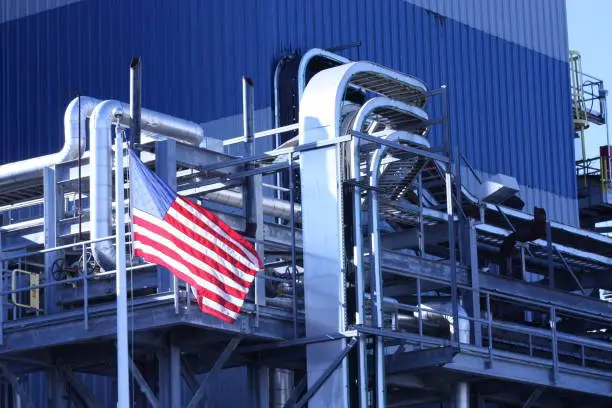Grants for Manufacturing in the USA to Boost Your Production Potential in 2024

Are you ready to revolutionize your manufacturing game? Discover exclusive Grants for Manufacturing in the USA, supercharging your production prowess. This article has tailor-made funding options and support programs designed to fuel the growth and innovation of your business. Don’t miss the chance to elevate your operations and dominate the competitive landscape!

Grants for manufacturing in the USA are financial resources provided by various government agencies, private organizations, or foundations to support and stimulate growth within the manufacturing sector. These grants are designed to assist businesses producing goods, ranging from small-scale enterprises to larger manufacturing companies.
The primary objectives of Grants for Manufacturing in the USA
1. Promoting Innovation: Grants encourage manufacturers to adopt innovative technologies, processes, and practices. This fosters increased efficiency, competitiveness, and the development of cutting-edge products.
2. Facilitating Expansion: Manufacturing grants often target business expansion and infrastructure development. This could involve the expansion of production facilities, the introduction of new product lines, or the enhancement of existing capabilities.
3. Workforce Development: Some grants focus on improving the skills and expertise of the manufacturing workforce. This can include training programs, apprenticeships, and initiatives to address skill gaps within the industry.
4. Environmental Sustainability: Many grants encourage environmentally sustainable practices within the manufacturing sector. Funding may be provided for projects that reduce environmental impact, promote energy efficiency, or incorporate eco-friendly technologies.
5. Job Creation: Supporting job creation is a common goal of manufacturing grants. By providing financial assistance to manufacturers, these grants contribute to the growth of employment opportunities within the industry.
Businesses interested in these grants must submit proposals or applications outlining their specific needs, proposed projects, and how the funds will be utilized. The application process often involves a competitive evaluation, where proposals are assessed based on innovation, economic impact, and alignment with the grant’s objectives.
Grants for manufacturing in the USA are pivotal in fostering a thriving and competitive manufacturing sector by providing the necessary financial support for growth, innovation, and sustainability.
A substantial portion of financial support for small and medium-sized manufacturers (SMMs) in the United States is derived from grants, loans, and private financiers. Approximately $500 billion in U.S. government expenditures are annually directed towards assistance across various sectors, with a noteworthy allocation designated explicitly for the manufacturing sector. The available capital for manufacturers has witnessed a notable increase in the aftermath of the COVID-19 pandemic, particularly with the enactment of legislation such as the CARES Act. Securing funding has become more accessible than ever before.
Below are several approaches through which SMMs can capitalize on these funding opportunities by actively seeking U.S. manufacturing grants.
What is a Grant
In its broadest sense, a grant refers to funds provided to businesses, typically with specific criteria dictating how these funds can be utilized to achieve particular objectives. These financial allocations may support various initiatives, ranging from training programs aimed at upskilling employees to projects focused on developing environmentally friendly processes such as recycling.
Notably, grants differ from other forms of funding available to manufacturers. Unlike tax credits, grants are subject to agreements between funders and recipients. In contrast to loans that require repayment, grants do not necessitate repayment unless there is a violation of the agreed-upon terms. Furthermore, grants exhibit flexibility not found in government contracts, which often have fixed availability. The availability of grants is contingent on state and federal budget cycles and is influenced by the prevailing political climate. The specifics of the funding arrangement will be contingent on the type of grant applied for and its designated purpose.
Different Kinds of Grants Available to SMMs
Various grants are available to Small and Medium-sized Manufacturers (SMMs), catering to diverse needs and initiatives. Here are some key categories:
1. Small Business Innovation Research (SBIR) and Small Business Technology Transfer (STTR) Grants:
Federally funded grants specifically for research and development (R&D) endeavors.
2. Technology-Based Economic Development (TBED) Awards:
Targeted at businesses demonstrating proof of concept for technology or showcasing enhancements to the workforce.
3. R&D and Commercialization Grants:
Support for innovative research and the commercialization of manufacturing processes.
4. Facilities and Capital Expansion Grants:
Drive investment, particularly for expanding the number, capacity, or type of facilities.
5. Training Grants:
Designed to support the upskilling of the manufacturing workforce.
6. Recycling Grants:
Aimed at diverting materials from landfills, encouraging sustainable waste management practices.
7. Energy Efficiency and Renewable Energy Grants:
Support the implementation of sustainable solutions and projects promoting energy efficiency.
8. Exporting Grants:
Assistance for SMMs engaged in international trade efforts.
9. Trade Adjustment and Assistance Center (TAAC) Grants:
Designed to help manufacturers navigate and mitigate the negative impacts of trade, often involving third-party expertise.
In some instances, states may complement federal funding by matching a portion of grants, such as reimbursing a segment of an SBIR award. The funding process can also vary, with certain grants, like training grants, typically provided as reimbursements after the completion of the proposed project. Understanding each grant type’s specific focus and eligibility criteria is crucial for SMMs seeking financial support in these various areas.
Manufacturing Grants from the Federal Government
The federal government provides numerous grant opportunities for small business owners, with specific offerings tailored to the manufacturing sector. Here’s a closer look at some popular manufacturing grants available from the federal government:
1. Grants.gov:
Grants.gov serves as a centralized platform consolidating all available federal grants. Utilizing the search function on the website enables businesses to identify relevant opportunities based on their eligibility.
2. Small Business Administration (SBA) Grants:
The SBA extends support to small manufacturers through various programs. Notable initiatives include Boots to Business, the Veterans Business Outreach Centers (VBOC), and the Program for Investors in Microentrepreneurs, all offering grants to eligible small businesses.
3. U.S. Chamber of Commerce Dream Big Awards:
The Dream Big Awards, facilitated by the U.S. Chamber of Commerce, aim to propel small businesses forward. While prize amounts vary, the top award in 2022 reached $25,000.
4. USDA Rural Development Grants:
The U.S. Department of Agriculture (USDA) administers grants through the Rural Business Development Program, focusing on fortifying rural communities. To qualify, businesses must operate in eligible areas, employ fewer than 50 individuals, and generate less than $1 million in gross revenue.
Exploring these federal government-sponsored opportunities provides small manufacturers diverse avenues to secure funding and support for their growth and development initiatives.

State and Local Grants for Manufacturing
In addition to federal grants, various state and local governments offer manufacturing grants to support businesses. Explore some of the opportunities below:
1. State Trade Expansion Program (STEP):
STEP grants aim to fund small businesses seeking to expand into international markets, facilitating global business growth.
2. Employability Business Grant:
In California, businesses creating job opportunities for individuals with disabilities can apply for grants ranging from $20,000 to $200,000, promoting inclusivity and workforce development.
3. Florida High Tech Corridor Research Grants:
Florida companies collaborating with researchers from the University of Central Florida or the University of South Florida to develop and commercialize new technologies can apply for grants, with amounts reaching up to $150,000.
4. CitizensNYC Neighborhood Business Grants:
Small businesses in New York City can seek grants of up to $10,000 through the CitizensNYC Neighborhood Business Grants program. Priority is given to businesses addressing specific community issues.
5. Amegy Bank Small Business Boost Program:
Small business owners in Houston with less than 500 employees can apply for grants of up to $5,000 through the Amegy Bank Small Business Boost Program.
It’s important to note that the mentioned grant opportunities are not exhaustive, and additional grants may be available in your local area. Conducting thorough research specific to your region can uncover more opportunities to support your manufacturing business.
Industry-specific Grants for Manufacturing
Manufacturing businesses pursuing grants have specialized opportunities beyond general small or startup grants. Noteworthy industry-specific manufacturing grants include:
1. Advanced Manufacturing Technology (MFGTech) Roadmap Program:
The MFGTech program extends funding opportunities to manufacturers at the forefront of advancing technology within the industry.
2. Department of Defence Manufacturing Technology Program:
Companies involved in manufacturing equipment crucial for national security needs can seek funding opportunities through the Department of Defence (DoD) Manufacturing Technology Program.
These industry-specific grants are tailored to address the distinctive needs and advancements within the manufacturing sector. They serve as targeted avenues for support, fostering technological innovation and contributions to national security through manufacturing excellence.
Non-Profit Manufacturing Grants
Numerous non-profit organizations provide small business grants, offering manufacturing companies additional avenues for financial support. Here are examples of non-profit grants:
1. National Association for the Self-Employed:
Self-employed business owners can apply for grants of up to $4,000 through the National Association for the Self-Employed.
Grants of up to $25,000 are available through the Hello Alice Grant program. This initiative supports businesses across various industries, including manufacturing.
These non-profit manufacturing grants contribute to the growth and sustainability of businesses by providing targeted financial assistance. Businesses in the manufacturing sector can explore these opportunities to secure funding for their specific needs and initiatives.
Other Grants for Manufacturing
While not fitting into specific categories, various grants provide additional opportunities for manufacturing businesses. Consider exploring the following options:
1. FedEx Small Business Grant Contest:
In 2023, FedEx will offer grants reaching $30,000 through their Small Business Grant Contest.
2. Fast Break for Small Business:
Sponsored by the NBA, this program provides grants of up to $10,000 through the Fast Break for Small Business initiative.
3. Lenovo Evolve Small Grant:
The Lenovo Evolve Small Grant offers awards of up to $10,000. To qualify, businesses must have revenue between $100,000 to $300,000.
These diverse grant opportunities, from corporate-sponsored initiatives to unique programs, provide additional avenues for manufacturing businesses to secure financial support for their growth and development. Exploring various options ensures businesses can find grants that align with their specific needs and objectives.
Understanding Manufacturing Grants
With various manufacturing grant options available, a comprehensive understanding of the process is crucial for successful applications. Here’s an overview of how manufacturing grants typically work:
How Do Manufacturing Grants Work?
1. Application Process:
Businesses interested in securing manufacturing grants must submit applications. While any business can apply, meeting the minimum requirements is essential for serious consideration.
2. Review of Applications:
Grant-providing organizations undertake a thorough review of each application. This evaluation process may involve individual assessments or public votes to make funding decisions.
3. Disbursement of Funds:
Once a business is selected to receive a grant, the funds are disbursed. Importantly, businesses can allocate funds according to their specific needs. The key advantage is that these funds do not need to be repaid.
Understanding this process allows businesses to navigate the grant application journey more effectively. By meeting eligibility criteria, presenting compelling applications, and aligning with the grant’s objectives, businesses increase their chances of securing valuable funding to support their manufacturing endeavors.
Qualifying for Manufacturing Grants
Not all businesses are eligible for manufacturing grants. Here are key considerations to keep in mind:
1. Read the Eligibility Requirements:
Each manufacturing grant opportunity comes with specific eligibility criteria. Thoroughly review these requirements before investing time in the application process.
2. Manufacturing Focus:
Some grants are open to all small businesses, but your business must produce goods or products for manufacturing-focused grants to qualify.
Why Are Manufacturing Grants Offered to Businesses?
While the prospect of free money is enticing, understanding the reasons behind offering manufacturing grants provides valuable context:
1. Economic Growth:
Small manufacturers play a crucial role in fostering economic growth. Offering grants is a strategic investment in the economy, aiming to support and stimulate the manufacturing sector.
2. Accelerating Growth:
Achieving growth in manufacturing often requires both time and capital. Grants serve as a means to accelerate the growth timeline for businesses, providing them with the financial support needed to expand and thrive.
By aligning with the specific focus of manufacturing grants and recognizing their role in economic development, businesses can better position themselves to qualify for these opportunities and leverage the support they provide.
How to Apply for a Manufacturing Grant in the U.S.
Successfully navigating the process of applying for manufacturing grants in the U.S. revolves around being well-prepared. The six steps are geared towards equipping you for most U.S. manufacturing grant applications.
Step 1: Registration and Submission of Financial Information
Achieving success in your application for state or federal grants begins with the initial registration of your business at either the federal or state level. For federal grant applications, businesses must possess a Data Universal Numbering System (DUNS), presently undergoing a transition to the Unique Entity Identifier (UEI). After obtaining a DUNS/UEI, businesses complete registration within the System for Award Management (SAM).
In contrast, state grants typically necessitate registration through a designated portal, accompanied by evidence showcasing your business presence in the specific state where the application is being submitted.
Upon successful registration with SAM and/or the state agency, Small and Medium-sized Manufacturers (SMMs) can pinpoint potential funding opportunities to apply for through grants.gov (for federal grants) or state economic development agencies.
Step 2: Comprehensive Examination of the RFP or NOFO
In the case of projects necessitating a Request for Proposal (RFP) or a Notice of Funding Opportunity (NOFO) at the federal level, a meticulous review of the proposal is essential. It is crucial to thoroughly understand the comprehensive instructions outlined in the proposal before initiating the application process. When completing an RFP or NOFO, Small and Medium-sized Manufacturers (SMMs) should prioritize articulating the strategies and activities intended for implementation to achieve the desired outcomes. This involves ensuring that responses directly, concisely, and comprehensively address all the specified evaluation criteria.
Step 3: Compilation of Required Information
In alignment with the guidelines stipulated in the RFP or NOFO, creating a comprehensive list of the specific information needed to complete the grant proposal is imperative.
This list may encompass, but is not restricted to, the following details:
1. The total number of employees in your business (with the stipulation that it must be fewer than 500 for SBIR applications).
2. Comprehensive particulars of the proposed project, elucidating goals and anticipated outcomes.
3. Audited financial statements spanning multiple years.
4. Social security numbers of trainees, a requisite for training grant applications.
Your business must furnish precisely the information specified in the RFP or NOFO to enhance the likelihood of a successful grant application. Any inaccuracies in the provided information may lead to disqualification.
Step 4: Development of an Application Timeline
Following a comprehensive understanding of the requirements outlined in the RFP or NOFO, it becomes imperative to establish a well-defined timeline that delineates the activities to be completed before each specified due date.
This entails allocating dedicated time and resources for information gathering from diverse stakeholders. Additionally, incorporating multiple rounds of draft reviews and application refinement is essential before the final submission. Ideally, a strategic approach involves being prepared to apply a week before the stipulated deadline. This proactive measure allows for contingencies and ensures a smooth submission process.
Step 5: Implementation of the Timeline
The to-do list formulated during the creation of the timeline serves as a guiding framework for your team to systematically accomplish the outlined activities. This includes the crucial stage of uploading and submitting the grant application to the designated portal.
Of utmost importance is incorporating a sufficient time buffer, allowing flexibility for making changes and reassessing components of the grant application well before the deadline. Typically, allocating a week before the deadline ensures ample time to address any necessary last-minute adjustments or navigate potential technical issues.
Step 6: Submission and Anticipation
After the application is completed, the final phase involves submitting the grant application through the relevant state or federal portal. Subsequently, your team awaits a decision. If the preceding steps have been diligently followed, this phase should be relatively straightforward, marking the culmination of the application process.

Funding Resources for Small and Medium-sized Manufacturers (SMMs)
Navigating the application process for state or federal government manufacturing grants need not be complex. Collaborating with partner organizations can simplify the procedure and enhance the likelihood of securing an award. SMMs across the nation can leverage various resources, including:
1. Procurement Technical Assistance Centers (PTACs):
PTACs offer valuable assistance in navigating the intricacies of government procurement processes. They guide grant applications and procurement opportunities.
2. Economic Development Centers/Corporations (EDCs):
EDCs play a pivotal role in supporting economic growth. They often assist SMMs by providing resources, mentorship, and information on available funding opportunities.
3. Small Business Development Centers (SBDCs):
SBDCs offer comprehensive support to small businesses, aiding in various aspects such as business planning, financial management, and grant application processes.
Dedicated to empowering women entrepreneurs, these centers provide specialized support, including guidance on grants and resources tailored to the unique needs of women-owned businesses.
Lakeview Consulting is a potential resource for SMMs, offering guidance and support in pursuing funding opportunities, including manufacturing grants.
By tapping into these resources, SMMs can enhance their understanding of the application process, access valuable guidance, and potentially increase their chances of successfully securing funding for their manufacturing endeavors.
Conclusion on Grants for Manufacturing in the USA
Grants for Manufacturing in the USA present invaluable opportunities for small and medium-sized businesses to fuel innovation, drive economic growth, and enhance their competitive edge. These grants, whether from federal, state, non-profit, or corporate sources, serve as financial catalysts, providing businesses with the means to invest in technology, workforce development, and sustainable practices. The diverse grants cater to industry-specific needs, reflecting a commitment to advancing manufacturing excellence.
Navigating the grant application process requires meticulous preparation, from understanding eligibility criteria to crafting compelling proposals. Leveraging industry-specific grants, non-profit initiatives, and corporate-sponsored opportunities broadens the spectrum of available funding. As manufacturing businesses secure grants, they contribute not only to their growth but also to the overall strength and dynamism of the manufacturing sector in the United States.
These grants signify a collaborative effort between businesses and funding organizations to foster innovation, job creation, and economic resilience. By tapping into these resources, manufacturing enterprises can access essential capital and propel themselves toward a future of sustainable success in the dynamic landscape of American industry.
RELATED
Do Grants Have to Be Paid Back?
Step-by-Step Guide: Applying for Grandparents Grant 2024
Top Service Dog Grants & Funding Resources 2024
Grants Pass Moving Companies 2024- Stress Free Relocation


